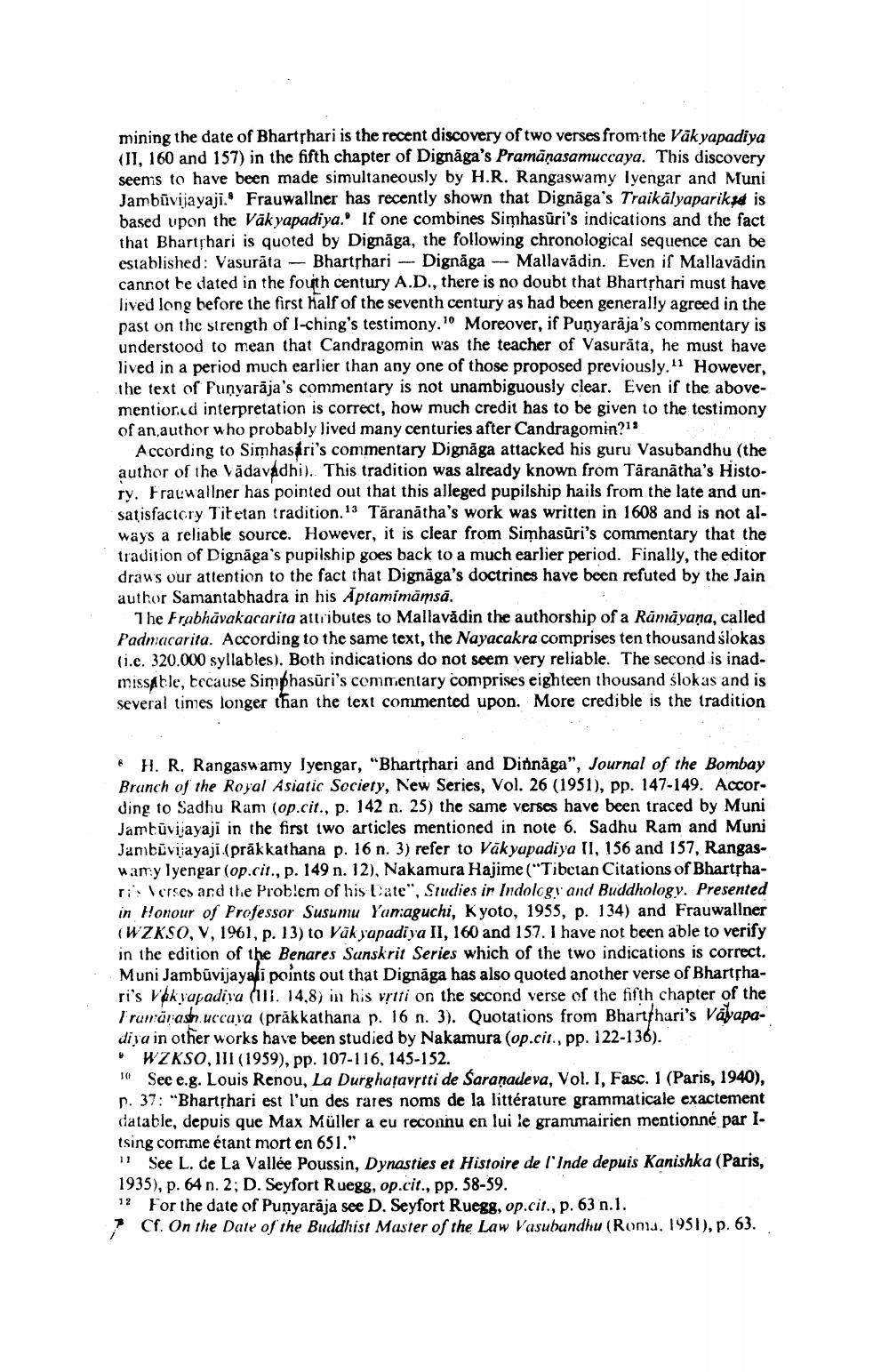Book Title: Nyayachakra Lekh Author(s): J W De Jong Publisher: J W De Jong View full book textPage 3
________________ mining the date of Bhartṛhari is the recent discovery of two verses from the Vakyapadiya (II, 160 and 157) in the fifth chapter of Dignaga's Pramāṇasamuccaya. This discovery seems to have been made simultaneously by H.R. Rangaswamy Iyengar and Muni Jambūvijayaji. Frauwallner has recently shown that Dignaga's Traikalyapariksa is based upon the Vakyapadiya. If one combines Simhasuri's indications and the fact that Bharthari is quoted by Dignaga, the following chronological sequence can be established: Vasurata Bhartṛhari- Dignaga Mallavādin. Even if Mallavadin cannot be dated in the fourth century A.D., there is no doubt that Bhartṛhari must have lived long before the first half of the seventh century as had been generally agreed in the past on the strength of I-ching's testimony. 10 Moreover, if Punyarāja's commentary is understood to mean that Candragomin was the teacher of Vasurata, he must have lived in a period much earlier than any one of those proposed previously. However, the text of Punyaraja's commentary is not unambiguously clear. Even if the abovementioned interpretation is correct, how much credit has to be given to the testimony of an author who probably lived many centuries after Candragomin?11 According to Simhasari's commentary Dignaga attacked his guru Vasubandhu (the author of the Vädavadhi). This tradition was already known from Täranätha's History. Frauwallner has pointed out that this alleged pupilship hails from the late and unsatisfactory Tibetan tradition. 13 Taranatha's work was written in 1608 and is not always a reliable source. However, it is clear from Simhasūri's commentary that the tradition of Dignaga's pupilship goes back to a much earlier period. Finally, the editor draws our attention to the fact that Dignaga's doctrines have been refuted by the Jain author Samantabhadra in his Aptamimāmsā. The Frabhavakacarita attributes to Mallavadin the authorship of a Rāmāyaṇa, called Padmacarita. According to the same text, the Nayacakra comprises ten thousand slokas (i.e. 320.000 syllables). Both indications do not seem very reliable. The second is inadmissable, because Simphasuri's commentary comprises eighteen thousand slokas and is several times longer than the text commented upon. More credible is the tradition H. R. Rangaswamy Iyengar, "Bhartṛhari and Dinnaga", Journal of the Bombay Branch of the Royal Asiatic Society, New Series, Vol. 26 (1951), pp. 147-149. According to Sadhu Ram (op.cit., p. 142 n. 25) the same verses have been traced by Muni Jambūvijayaji in the first two articles mentioned in note 6. Sadhu Ram and Muni Jambūvijayaji (prākkathana p. 16 n. 3) refer to Vakyapadiya II, 156 and 157, Rangaswamy Iyengar (op.cit., p. 149 n. 12), Nakamura Hajime ("Tibetan Citations of Bhartṛharis Verses and the Problem of his Date", Studies in Indology and Buddhology. Presented in Honour of Professor Susumu Yamaguchi, Kyoto, 1955, p. 134) and Frauwallner (WZKSO, V, 1961, p. 13) to Vakyapadiya II, 160 and 157. I have not been able to verify in the edition of the Benares Sanskrit Series which of the two indications is correct. Muni Jambūvijayai points out that Dignaga has also quoted another verse of Bhartṛhari's Vakyapadiva (1. 14,8) in his vrtti on the second verse of the fifth chapter of the Framanash uccaya (prakkathana p. 16 n. 3). Quotations from Bharthari's Vayapadiya in other works have been studied by Nakamura (op.cit., pp. 122-136). 9 8 WZKSO, III (1959), pp. 107-116, 145-152. See e.g. Louis Renou, La Durghatavṛtti de Saraṇadeva, Vol. I, Fasc. 1 (Paris, 1940), p. 37: "Bhartṛhari est l'un des rares noms de la littérature grammaticale exactement datable, depuis que Max Müller a eu reconnu en lui le grammairien mentionné par Itsing comme étant mort en 651." 11 See L. de La Vallée Poussin, Dynasties et Histoire de l'Inde depuis Kanishka (Paris, 1935), p. 64 n. 2; D. Seyfort Ruegg, op.cit., pp. 58-59. 12 For the date of Punyarāja see D. Seyfort Ruegg, op. cit., p. 63 n.1. Cf. On the Date of the Buddhist Master of the Law Vasubandhu (Roma, 1951), p. 63. 10 7Page Navigation
1 2 3 4 5 6
